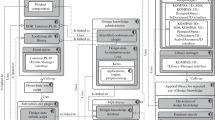Abstract
This paper presents an incremental approach to geometric constraint satisfaction that is suitable for interactive design by categorizing solutions into so called quanta. A quantum is a range of solutions with uniform geometric characteristics. In this way, the constraint management system keeps the intermediate solutions in the geometric domain, so that new geometric constraints can be interpreted on the same high level of abstraction. This approach leads to a number of advantages: the system
-
•can handle (perhaps temporarily) under-constrained specifications,
-
•represents both alternative discrete solutions and continuous ranges of solutions,
-
•performs satisfaction locally and incrementally,
-
•supports constraint inference and geometric reasoning,
-
•preserves the declarative semantics of constraints.
Access this chapter
Tax calculation will be finalised at checkout
Purchases are for personal use only
Preview
Unable to display preview. Download preview PDF.
Similar content being viewed by others
References
Arbab, F. and Wang, B. (1989). A geometric constraint management system in Oar. In ten Hagen, P. J. W. and Veerkamp, P., editors, Intelligent CAD Systems III — Practical Experience and Evaluation (Proceedings 3rd Eurographics Workshop on Intelligent CAD Systems, 1989), pages 231-252. Springer-Verlag.
Arbab, F. and Wing, J. M. (1985). Geometric reasoning: A new paradigm for processing geometric information. In Yoshikawa, H. and Warman, E. A., editors, Design Theory for CAD (Proceedings of the IFIP WG. 5.2 Working Conference, 1985), pages 145-165. Elsevier Science Publishers.
Badler, N. I. and Kamran, H. (1987). Articulated figure positioning by multiple constraints. IEEE Computer Graphics & Applications (special issue on articulated figure animation, 7(6):28–38.
Borning, A. (1981). The programming language aspects of ThingLab, a constraint-oriented simulation laboratory. ACM Transactions on Programming Languages and Systems, 3(4):353–387.
Cohen, J. (1990). Constraint logic programming languages. Communications of the ACM, 33(7):52–68.
Cournarie, E. and Beaudouin-Lafon, M. (1992). Alien: a prototype-based constraint system. In this volume.
Davenport, J. H., Siret, Y., and Tournier, E. (1988). Computer Algebra — systems and algorithms for algebraic computation. Academic Press.
Davis, E. (1987). Constraint propagation with interval labels. Artificial Intelligence, 32:281–331.
Emmerik, M. J. G. M. v. (1990). A system for interactive graphical modeling with 3D constraints. In Proceedings Computer Graphics International’ 90, pages 361-376. Sringer-Verlag.
Freeman-Benson, B. N. (1990). Kaleidoscope: Mixing objects, constraints, and imperative programming. (ECOOP/OOPSLA’ 90 Proceedings) SIGPLAN Notices, 25(10):77–88.
Heintze, N. C, Michaylov, S., and Stuckey, P. J. (1987). CLP(K) and some problems in electrical engineering. In Lassez, J.-L., editor, Proceedings of the 4th International Conference on Logic Programming. MIT Press.
Helander, M., editor (1988). Handbook of Human-Computer Interaction. North-Holland.
Laffra, C. and van den Bos, J. (1991). Propagators and concurrent constraints. OOPS Messenger 2(2):68–72.
Leier, W. (1988). Constraint Programming Languages, Their Specification and Generation. Addison-Wesley.
Lin, V. C., Gossard, D. C, and Light, R. A. (1981). Variational geometry in computer-aided design. (Proceedings SIGGRAPH’ 81) Computer Graphics, 15(3):171–177.
Mäntylä, M. (1988). An Introduction to Solid Modeling. Computer Science Press.
Moon, D. A. (1989). The common lisp object-oriented programming language. In Kim, W. and Lochovsky, F., editors, Object-Oriented Concepts, Databases, and Applications. ACM Press/Addison Wesley.
Nelson, G. (1985). Juno, a constraint-based graphics system. Proceedings SIGGRAPH’ 85, Computer Graphics, 19(3):235–243.
Pratt, M. J. (1987). Form Features and their Applications in Solid Modeling, Tutorial SIGGRAPH—87.
Quintus (1990). Quintus Prolog User Manual. Quintus Computer Systems, Inc.
Rankin, J. R. (1992). A graphical object oriented constraint solver. In this volume.
Rankin, J. R. and Burns, J. (1991). Coordinate frames and geometric approximation in graphics object oriented programming. In E. Blake, and P. Wißkirchen, editors, Advances in Object-Oriented Graphics I, pages 131-148. Springer-Verlag.
Rossignac, J. R. (1986). Constraints in constructive solid geometry. In Crow, F. and Pizer, S. M., editors, Proceedings of the 1986 ACM Workshop on Interactive 3D Graphics, pages 93-110. ACM Press.
Shapiro, E. and A. Takeuchi (1983). Object-oriented programming in concurrent Prolog. New Generation Computing, 1(1):25–48.
Steele Jr., G. L. and Sussman, G. J. (1979). CONSTRAINTS. APL Quote Quad, 9(4-Part 1):208–225.
Stroustrup, B. (1986). The C++ Programming Language. Addison Wesley.
Sutherland, I. (1963). Sketchpad: A man-machine graphical communication system. In Proceedings of the Spring Joint Computer Conference (IFIPS), pages 329-345.
Szekely, P. and Myers, B. (1988). A user-interface toolkit based on graphical objects and constraints. In Proceedings of the 1988 ACM Conference on Object-Oriented Programming Systems, Languages, and Applications, pages 36-45. ACM.
Veltkamp, R. C. (1991). Geometric constraint management with quanta. In Brown, D. C., Waldron, M., and Yoshikawa, H., editors, Proceedings of the IFIP TC5/WG5.2 Working Conference on Intelligent Computer Aided Design, Columbus, Ohio, September 1991). To be published by North-Holland.
Veltkamp, R. C. and Arbab, F. (1992). Geometric constraint propagation with quantum labels. In B. Falcidieno, I. Herman, and C. Pienovi, editors, Computer Graphics and Mathematics, pages 211-228. Springer-Verlag.
Zaniolo, C. (1984). Object-oriented programming in Prolog. In Proceedings of the IEEE International Symposium on Logic Programming, pages 265-270. IEEE.
Editor information
Editors and Affiliations
Rights and permissions
Copyright information
© 1995 EUROGRAPHICS The European Association for Computer Graphics
About this chapter
Cite this chapter
Veltkamp, R.C. (1995). A Quantum Approach to Geometric Constraint Satisfaction. In: Laffra, C., Blake, E.H., de Mey, V., Pintado, X. (eds) Object-Oriented Programming for Graphics. Focus on Computer Graphics. Springer, Berlin, Heidelberg. https://doi.org/10.1007/978-3-642-79192-5_6
Download citation
DOI: https://doi.org/10.1007/978-3-642-79192-5_6
Publisher Name: Springer, Berlin, Heidelberg
Print ISBN: 978-3-642-79194-9
Online ISBN: 978-3-642-79192-5
eBook Packages: Springer Book Archive




